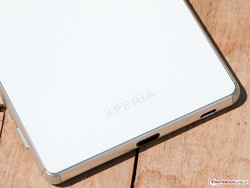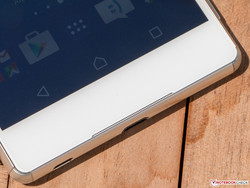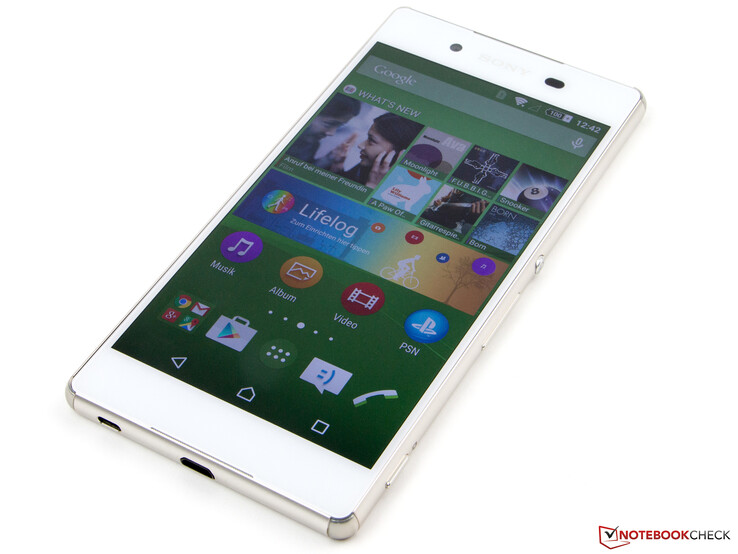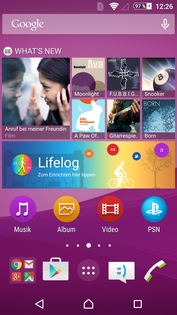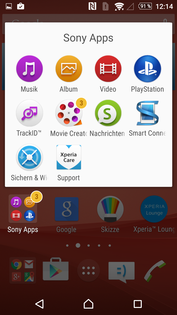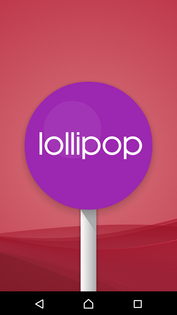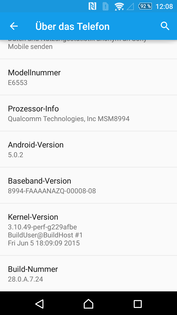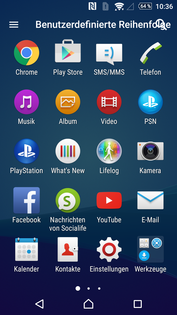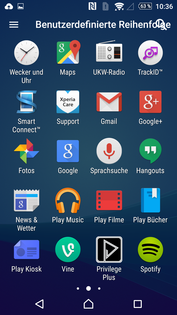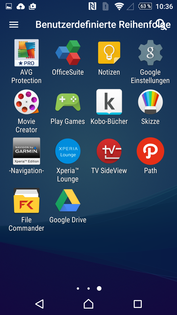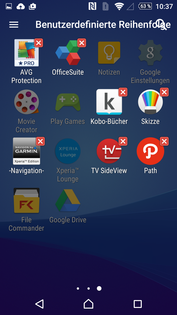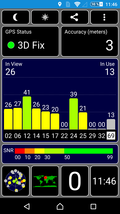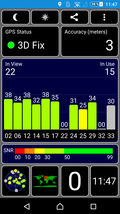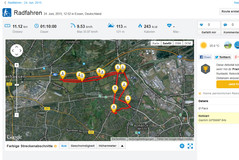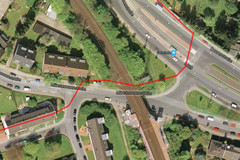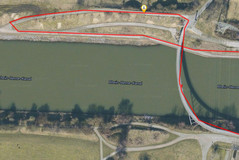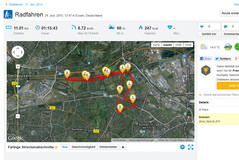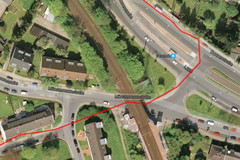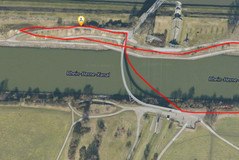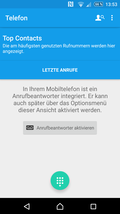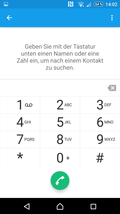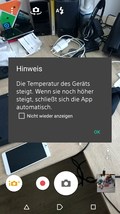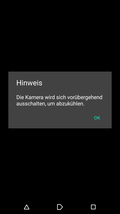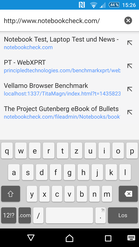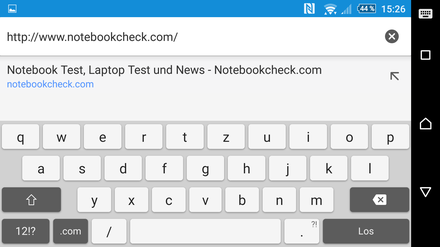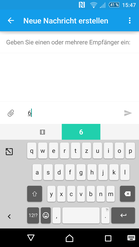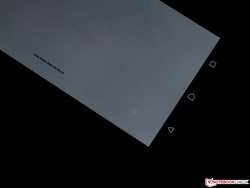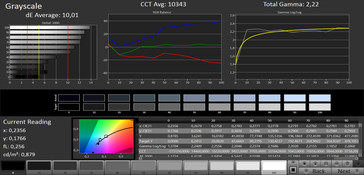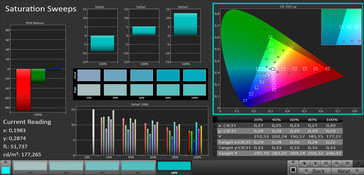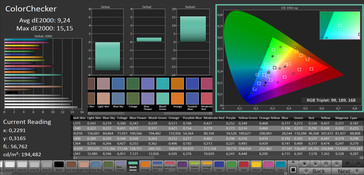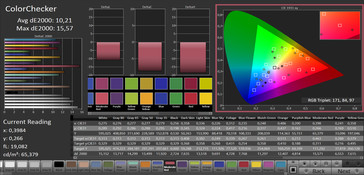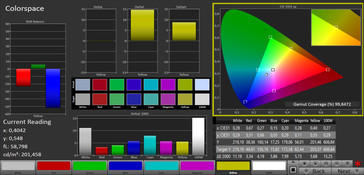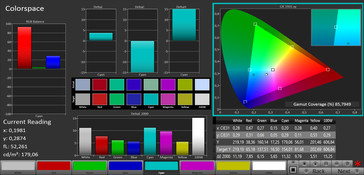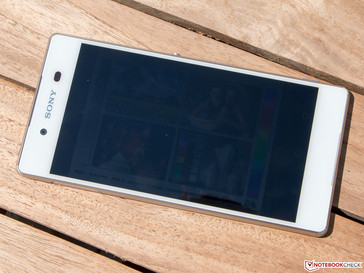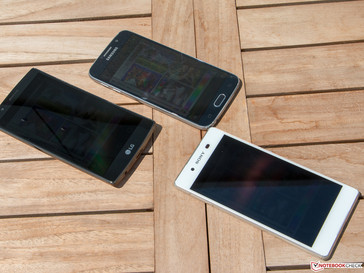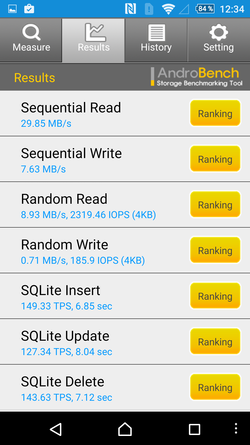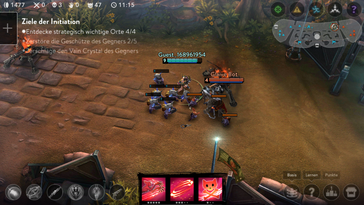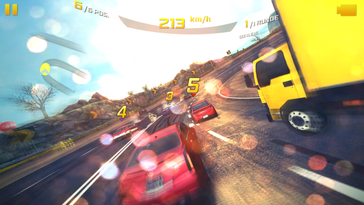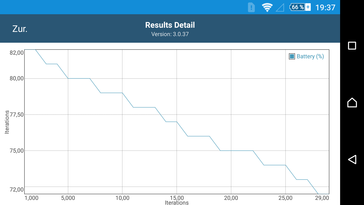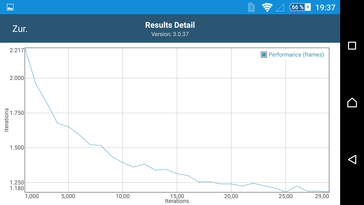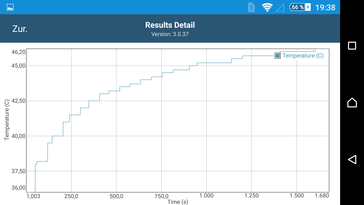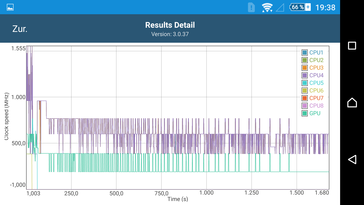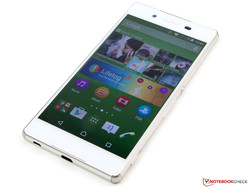Sony Xperia Z3 Plus Smartphone Review
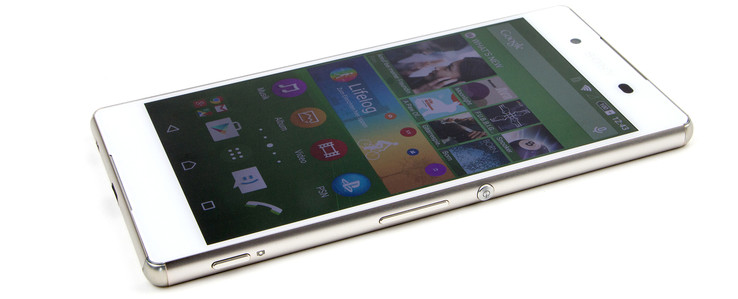
For the original German review, see here.
The Sony Xperia Z3+ was only supposed to be a small upgrade of its predecessor Xperia Z3. However, this has not really worked, even though the specs are actually good. The smartphone has all the connectivity options you could wish for and supports the most modern communication modules. The Japanese flagship device now has a 64-bit processor with the Snapdragon 810, but the latter is known for its high temperature development. Moreover, this is actually the biggest problem of the Z3+. Sony charges 699 Euros (~$770) for a smartphone that does not appear to be ready for the launch.
The high-end competition is very strong. Only the HTC One M9 uses this SoC as well, while LG has chosen the slightly weaker Snapdragon 808 for the G4, and the iPhone 6 Plus and the Galaxy S6 Edge use their own creations. Despite its age, the Lumia 930 is also a strong rival. Other comparison devices are the Huawei P8, the Moto X and the Nexus 6.
Case
The Sony Xperia Z3+ is slightly smaller than its predecessor from all sides. The manufacturer also claims that it is slimmer at just 6.9 millimeters (~0.27 in). We measured this and noticed that it is actually thicker. Our review unit is 7.2 millimeters (~0.28 in) high and therefore just 0.1 millimeter slimmer than the Z3.
You will immediately notice the missing docking port. This is unfortunate since the small charging station was actually pretty handy. It will also be annoying for users of the predecessors, since once again, a charging station cannot be used by the successor. The USB port is now open and does not have to be protected by a cover anymore. The Xperia Z3+ is still protected against dust and humidity (IP68). It is currently the only high-end smartphone with these features.
The design of the chassis is actually convenient and quite appealing with the materials hardened mineral glass as well as aluminum. Despite its size, the smartphone fits well in the hand. However, the gaps are not always very even and the glass does not sit flush with the frame everywhere. This should not happen on a premium device. It is nice that the product labels are located on a sheet of paper in the card slot and were not printed onto the chassis.
Twisting attempts seem to be distressing to the device since you can clearly hear creaking. Although it cannot really be twisted, these noises sound rather alarming. Even light pressure on the screen immediately results in ripples on the screen. The situation is much better at the back of the device.
The battery of the Z3+ is integrated. The slot cover is firmly integrated and covers one slot that can accommodate the microSD card as well as the Nano-SIM. However, this piece of plastic does not leave a very sturdy impression.
Connectivity
The connectivity of the Sony Xperia Z3+ does not really leave anything to be desired. The Micro-USB 2.0 port can be used for data transfers with a PC as well as charging. If you attach the Z3+ to a PC, you are immediately asked if you want to install Sony’s PC Companion, so you do not have to download it from the website of the manufacturer first. The port also supports OTG, which means you can attach external input devices or storage drives via adaptor. MHL 3.0 is supported as well, so you can transfer Ultra-HD contents to a compatible display with an optional cable.
If you prefer to transfer your media files wirelessly, you can use either DLNA or Miracast. The latter works very well, but unfortunately there is no sound in combination with an Amazon Fire TV stick. Although the problem seems to be known, it is not clear if it is caused by Amazon or Sony.
The microSD slot can be used to expand the storage by up to 128 GB. Apps cannot be directly installed onto the additional storage, but it was possible to transfer the majority of apps onto the card after the installation. It is rather inconvenient that the memory card and the SIM card are located in the same slot. This means you also have to remove the SIM card if you want to switch the microSD. The Z3+ restarts in this case and again, when you insert the SIM card. You should turn the smartphone off if you want to switch one of the cards as this will at least save one restart.
It is also possible to use the FM radio in combination with a headset that works as an antenna. The only missing communication feature is an infrared port.
Software
The Sony Xperia Z3+ is shipped with Google Android 5.0.2, but the manufacturer has also installed its own user interface (UI), which is hardly different from the predecessor. Sony distributed a new firmware at the beginning of the review (28.0.A.7.24), which is supposed to solve some of the heat issues. However, this update is not available via OTA, and has to be installed via a computer with Sony’s PC Companion. Another update is supposed to follow.
Once again, Sony has installed numerous apps and services on its smartphone. These also include some apps that can be used in combination with the PlayStation, the fitness hub Lifelog and the media hub What’s New. They are easy to delete if you do not want them. PS4 Remote Play can be used to connect a DualShock 4 Wireless Controller and show the picture from the PlayStation on the smartphone. This means that you can use the gaming console with the smartphone.
Unfortunately, Sony has also installed some third-party apps including Vine, Facebook, Spotify, AVG Protection Antivirus and MobiSystem’s OfficeSuite 8. These applications can be deleted as well.
Communication & GPS
The Sony Xperia Z3+ uses Qualcomm’s latest Wi-Fi module and supports all the current IEEE 802.11 a/b/g/n/ac standards including the MIMO technology for a better signal quality. It works in 2.4 as well as 5 GHz networks and is supposed to manage transfer rates of up to 867 Mbps. The range of the component is very good and there is no cause for criticism. The 5 GHz network generally shows a slightly higher damping and high fluctuations (-70 up to -82 dBm) at a greater distance to the access point (AP). However, this does not seem to be a problem in practice, and it was easy to watch a Netflix HD stream at a long distance to the AP on both networks.
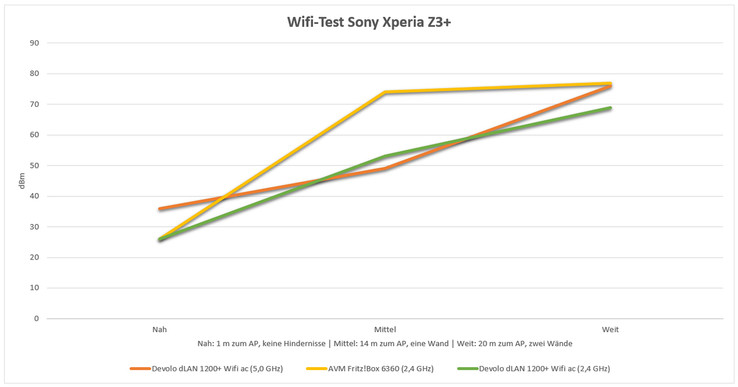
Mobile Internet connections can be established via HSPA+ (up to 42 Mbps) or fast LTE Cat. 6 (up to 300 Mbps) on the Xperia Z3+. Sony has also implemented a wide coverage of frequencies, so it should be possible to use a data connection in many countries all over the world. We could not notice any irregularities in terms of the signal quality.
The position of the Sony Xperia Z3+ can be located via GPS, GLONASS as well as BeiDou. The Satfix was also very fast and accurate indoors, and we could hardly notice a difference compared to the use outdoors as long as there was not too much concrete in the way.
We checked the accuracy of the GPS module on a bicycle ride and compared it with the outdoor navigation device Garmin GPSMAP 64s. The narrow street section and the bridge crossing in particular show that the navigation device locates the position much more often and it is therefore more accurate. However, the differences over the whole track length are comparatively small at less than 1% (110 meters/361 ft). A great result. The GPS module in the smartphone does not drain the battery that much, either, the battery capacity was only reduced by five percent after the 75-minute bicycle ride.
Telephone & Voice Quality
The voice quality of the Sony Xperia Z3+ is very good. When the device is held against the ear, both parties could easily hear and understand each. Unfortunately, the ambient noise suppression was not always perfect, but the caller was easy to understand. Our voice echoed via the hands-free feature, but the phone acoustics were always good, even when the smartphone was lying next to us on the table. The supplied headset also leaves a good impression. The other person appeared slightly muffled, but the in-ear plugs suppressed external noises quite well. The microphone of the headset was also impressive.
The phone app has a simple layout and provides an automatic list with frequently called contacts. There is also an integrated answering machine.
Cameras
Sony has followed the current trend and upgraded the front camera of the Xperia Z3+. The camera can now take pictures with up to 5 MP (2592x1944 pixels, 4:3) and the 25 mm wide angle lens ensures that more than one person can be captured in one picture. The results are quite good and show only a slight red hue. The camera tends to overexpose slightly in bright environments. A three-stage soft-focus is available, so it is possible to take good selfies.
The main camera uses a 20.7 MP sensor (5248x3936 pixels, 4:3), but this resolution can only be selected in the manual mode. If you want to use the automatic mode, you have to live with almost 8 MP (3264x2448 pixels, 4:3). We used this mode for our comparison pictures.
At a first glance, the environment picture (Scene 1) of the review unit appear very dynamic, but a closer look shows that details like the leaves of the trees lack contours and sometimes appear very blurry. You get much better results in the manual mode. The picture in Scene 2 is much sharper, but the automatic HDR mode cannot prevent the overexposure of the sky. However, other rivals suffer from the same issue. The colors are slightly richer, and the results are very good. The low-light performance of the camera is impressive as well and the results can actually compete with other devices. The aperture (f/2.0) is slightly smaller than the Galaxy S6 (f/1.9) or the LG G4 (f/1.8), but Sony can compensate this with a higher light sensitivity. The Xperia Z3+ uses ISO 3200 in the manual mode or even ISO 12800 in the low-light mode. It is handy that the image stabilizer can be deactivated.
The smartphone can record videos in Ultra-HD (3840x2160 pixels, 30 fps, 53 Mbps). If you only want Full-HD clips, you can choose between 30 (16.0 Mbps) and 60 (29.5 Mbps) frames per second. Slow-motion videos and time lapses are also possible. Although the quality is decent, you can see some small fragments from time to time, which are mainly visible when you move the camera.
So is everything great? Unfortunately not. The camera has big issues with the heat development of the device and just turns itself off to protect the smartphone against overheating. This phenomenon can be quickly observed in the 4K mode in particular. The Z3+ will only last for about half a minute, even with the latest firmware. There can also be problems when you use the AR effects or the normal webcam after a few minutes and the camera will turn off (see video). The camera even refused to start at all on very hot days. Sony has to fix this issue very quickly.
Accessories
Contrary to the current trend, Sony still provides some accessories: You get a modular power adaptor (5.0 Volts, 1.5 Amps) with a nominal output of 7.5 watts, a USB cable, a headset and an OTG adaptor. The latter is a particularly unique addition.
Sony did not list any dedicated accessories for the smartphone at the time of this review, but you can expect some products soon.
Warranty
Sony offers a 24-month warranty for its product.
Input Devices & Handling
The capacitive touchscreen of the Sony Xperia Z3+ recognizes up to ten inputs simultaneously and executes them quickly and reliably. The gliding capabilities are also good. However, pressing the touchscreen too hard can cause ripples on the display. The Glove mode also ensures the handling with covered hands, even though it is not quite as reliable as we are used to.
The virtual keyboard is quite simple and identical to that of the predecessor. Because of the large display, there would have been enough space for an additional row with numbers or special characters. It is nice that you can quickly switch to a one-hand mode, and the keyboard supports other features like Swype inputs or automatic word predictions.
The physical keys have a firm pressure point and appear very sophisticated. Even a dedicated camera button is available, which can launch the camera app and trigger the pictures.
Display
The IPS display of the Sony Xperia Z3+ measures 5.2 inches and has a resolution of 1920x1080 pixels. This corresponds with a screen ratio of 16:9 as well as a pixel density of around 424 ppi. The panel is razor-sharp, even without the QHD resolution. This means that nothing has changed compared to the predecessor Xperia Z3. Once again, the luminance is supposed to be as high as 700 cd/m², but we cannot confirm this in the case of our review unit. However, the visuals are not perfect, because there is a thick light spot on the display, which is visible with plain backgrounds.
The brightness distribution is very even at 92% and there is no criticism here. The luminance also surpasses its rivals in the class category.
| |||||||||||||||||||||||||
Brightness Distribution: 92 %
Center on Battery: 605 cd/m²
Contrast: 1142:1 (Black: 0.53 cd/m²)
ΔE ColorChecker Calman: 9.24 | ∀{0.5-29.43 Ø4.77}
ΔE Greyscale Calman: 10.01 | ∀{0.09-98 Ø5}
97.1% sRGB (Argyll 1.6.3 3D)
65.65% AdobeRGB 1998 (Argyll 1.6.3 3D)
Gamma: 2.22
CCT: 10343 K
| Sony Xperia Z3+ Adreno 430, 810 MSM8994, 32 GB eMMC Flash | LG G4 Adreno 418, 808 MSM8992, 32 GB eMMC Flash | Apple iPhone 6 Plus PowerVR GX6450, A8, 64 GB eMMC Flash | Huawei P8 Mali-T628 MP4, Kirin 930, 16 GB eMMC Flash | HTC One M9 Adreno 430, 810 MSM8994, 32 GB eMMC Flash | Nokia Lumia 930 Adreno 330, 800 MSM8974, 32 GB eMMC Flash | Samsung Galaxy S6 Edge Mali-T760 MP8, Exynos 7420, 32 GB UFS 2.0 Flash | |
|---|---|---|---|---|---|---|---|
| Screen | 8% | 6% | 18% | 4% | -23% | 17% | |
| Brightness middle (cd/m²) | 605 | 566 -6% | 519 -14% | 453 -25% | 474 -22% | 275 -55% | 343 -43% |
| Brightness (cd/m²) | 601 | 536 -11% | 496 -17% | 439 -27% | 458 -24% | 278 -54% | 338 -44% |
| Brightness Distribution (%) | 92 | 90 -2% | 90 -2% | 91 -1% | 85 -8% | 89 -3% | 94 2% |
| Black Level * (cd/m²) | 0.53 | 0.47 11% | 0.62 -17% | 0.28 47% | 0.4 25% | ||
| Contrast (:1) | 1142 | 1204 5% | 837 -27% | 1618 42% | 1185 4% | ||
| Colorchecker dE 2000 * | 9.24 | 6.17 33% | 3.67 60% | 4.7 49% | 6.32 32% | 10.99 -19% | 2.2 76% |
| Greyscale dE 2000 * | 10.01 | 6.26 37% | 3.78 62% | 5.03 50% | 6.36 36% | 8.29 17% | 2.37 76% |
| Gamma | 2.22 99% | 2.48 89% | 2.42 91% | 2.27 97% | 2.43 91% | 2.16 102% | 2.41 91% |
| CCT | 10343 63% | 8171 80% | 7327 89% | 7439 87% | 8218 79% | 6731 97% | 6425 101% |
| Color Space (Percent of AdobeRGB 1998) (%) | 65.65 | 65.48 0% | 72.04 10% | 58.81 -10% | 87.77 34% | ||
| Color Space (Percent of sRGB) (%) | 97.1 | 98.63 2% |
* ... smaller is better
The black value of the Sony Xperia Z3+ is slightly raised at 0.53 cd/m² and one of the highest amongst the rivals. Only the iPhone 6 Plus (0.62 cd/m², 837:1) is worse in this category. Thanks to the high luminance, you still get a great contrast ratio of 1142:1. The Z3+ is on par with the LG G4 and the HTC One M9 in this respect. Apart from OLED smartphones, the Huawei P8 is the benchmark.
The display shows the same problem as the predecessor Z3 in terms of color presentation when using the standard settings. The grayscale shows a strong blue cast and colors deviate heavily from the ideal values. You can get much better results via the manual white balance. Please have a look at the review of the Xperia Z3 for recommended values, where we have illustrated the differences.
Sony advertises an sRGB color space coverage of 130%. This is nonsense from a logical point of view, but it certainly sounds good for marketing. The actual sRGB coverage is at 97% and the wider AdobeRGB color space can be covered by almost 66%. These are good results, but not quite as good as the Huawei P8 or the Galaxy S6 Edge.
The Sony Xperia Z3+ should be impressive in the outdoors, because it has a very high luminance and a good contrast. The glossy display can be a problem under direct sunlight, but once again, the biggest issue is the temperature development of the smartphone.
Everything was good when we took the Z3+ outside for the first time. The display content was easy to see, but we suddenly noticed that the visibility was affected while we watched a movie. The display actually dimmed the brightness regardless of whether we activated the brightness sensor or not. The previously measured 610 cd/m² dropped to about 350 cd/m². The LG G4 suffered from a similar issue, but at least the rival does not hide the fact that the brightness is reduced and actually indicates it. Sony's smartphone, however, wants us to believe that it runs at the highest panel brightness.
The reason is most likely the high temperature development, so the outdoor capabilities are noticeably affected.
Performance
At the heart of the Sony Xperia Z3+ is a Snapdragon 810 MSM8994 from Qualcomm. It is supported by 3 GB of memory and the integrated GPU Adreno 430. The 64-bit Octa-Core also used in the LG Flex 2 and the HTC One M9 is quite fast, but it is also known for its thermal issues. HTC finally took care of the problem with a slight throttling. The benchmark results of the review unit are impressive and usually in the expected range. However, the handling shows that things do not always run smoothly, especially after you have used very demanding apps.
The Z3+ can take a top position in many benchmarks. However, the Exynos 7420 inside the Galaxy S6 and the S6 Edge cannot be beaten. The results in AnTuTu and PCMark for Android are good, both the CPU as well as the GPU performance are on the expected level. However, the benchmarks indicate throttling of the SoC, which will be confirmed later in the review. Only in the AndEBench Pro comparisons does the Z3+ occupy the last place.
| PCMark for Android - Work performance score (sort by value) | |
| Sony Xperia Z3+ | |
| HTC One M9 | |
| Asus Zenfone 2 ZE551ML | |
| LG G4 | |
| Samsung Galaxy S6 Edge | |
| OnePlus One | |
| LG G Flex 2 | |
| Huawei P8 | |
| 3DMark | |
| 1280x720 offscreen Ice Storm Unlimited Score (sort by value) | |
| Sony Xperia Z3+ | |
| Sony Xperia Z3 | |
| HTC One M9 | |
| Asus Zenfone 2 ZE551ML | |
| Apple iPhone 6 Plus | |
| LG G4 | |
| Samsung Galaxy S6 Edge | |
| Google Nexus 6 | |
| Motorola Moto X 2. Gen 2014 | |
| OnePlus One | |
| LG G Flex 2 | |
| Huawei P8 | |
| 1280x720 offscreen Ice Storm Unlimited Graphics Score (sort by value) | |
| Sony Xperia Z3+ | |
| Sony Xperia Z3 | |
| HTC One M9 | |
| Asus Zenfone 2 ZE551ML | |
| Apple iPhone 6 Plus | |
| LG G4 | |
| Samsung Galaxy S6 Edge | |
| Google Nexus 6 | |
| Motorola Moto X 2. Gen 2014 | |
| OnePlus One | |
| LG G Flex 2 | |
| Huawei P8 | |
| 1280x720 offscreen Ice Storm Unlimited Physics (sort by value) | |
| Sony Xperia Z3+ | |
| Sony Xperia Z3 | |
| HTC One M9 | |
| Asus Zenfone 2 ZE551ML | |
| Apple iPhone 6 Plus | |
| LG G4 | |
| Samsung Galaxy S6 Edge | |
| Google Nexus 6 | |
| Motorola Moto X 2. Gen 2014 | |
| OnePlus One | |
| LG G Flex 2 | |
| Huawei P8 | |
| 2560x1440 Sling Shot OpenGL ES 3.0 (sort by value) | |
| Sony Xperia Z3+ | |
| HTC One M9 | |
| LG G4 | |
| Samsung Galaxy S6 Edge | |
| 2560x1440 Sling Shot Extreme (ES 3.1) (sort by value) | |
| Sony Xperia Z3+ | |
| HTC One M9 | |
| LG G4 | |
| Samsung Galaxy S6 Edge | |
| GFXBench 3.1 | |
| on screen Manhattan ES 3.1 Onscreen (sort by value) | |
| Sony Xperia Z3+ | |
| HTC One M9 | |
| LG G4 | |
| Samsung Galaxy S6 Edge | |
| LG G Flex 2 | |
| 1920x1080 Manhattan ES 3.1 Offscreen (sort by value) | |
| Sony Xperia Z3+ | |
| HTC One M9 | |
| LG G4 | |
| Samsung Galaxy S6 Edge | |
| LG G Flex 2 | |
| Basemark ES 3.1 / Metal - offscreen Overall Score (sort by value) | |
| Sony Xperia Z3+ | |
| HTC One M9 | |
| LG G Flex 2 | |
| Lightmark - 1920x1080 1080p (sort by value) | |
| Sony Xperia Z3+ | |
| HTC One M9 | |
| Asus Zenfone 2 ZE551ML | |
| LG G4 | |
| Samsung Galaxy S6 Edge | |
| OnePlus One | |
| LG G Flex 2 | |
We checked the browser performance with the preloaded Google Chrome (version 43). The results of the Xperia Z3+ are usually average, but there is one unexpected low result in Basemark OS II, where it is at the bottom of the ranking.
Subjectively, however, there is no criticism, and websites are loaded very quickly.
| Vellamo 3.x - Browser (sort by value) | |
| Sony Xperia Z3+ | |
| Sony Xperia Z3 | |
| HTC One M9 | |
| Asus Zenfone 2 ZE551ML | |
| LG G4 | |
| Samsung Galaxy S6 Edge | |
| Google Nexus 6 | |
| Motorola Moto X 2. Gen 2014 | |
| OnePlus One | |
| LG G Flex 2 | |
| Huawei P8 | |
| Browsermark - 2.1 (sort by value) | |
| Sony Xperia Z3+ | |
| HTC One M9 | |
| LG G4 | |
| Samsung Galaxy S6 Edge | |
| Nokia Lumia 930 | |
| Motorola Moto X 2. Gen 2014 | |
| OnePlus One | |
| LG G Flex 2 | |
| Huawei P8 | |
* ... smaller is better
The Sony Xperia Z3+ is equipped with 32 GB eMMC flash storage, and about 21 GB can be used for your own files after the initial setup. The performance has improved significantly compared to the predecessor, but is still just average among the high-end competition. The review unit can only keep up with the best devices in terms of the sequential reading performance.
It is possible to expand the storage by up to 128 GB via a microSD card. According to the specifications, the slot supports class 10 (UHS-I Grade 1) cards. We checked the performance of the slot with a memory card (Samsung EVO 64 GB MB-MP64D, read: 48 Mbps, write 20 Mbps) and noticed that it cannot utilize the full performance of our card. We measured only 29.85 Mbps (sequential read) and 7.63 Mbps (sequential write), respectively, in the Z3+. This means that you have to be patient if you want to copy large amounts of data.
| PassMark PerformanceTest Mobile V1 - Disk Tests (sort by value) | |
| Sony Xperia Z3+ | |
| Sony Xperia Z3 | |
| HTC One M9 | |
| Asus Zenfone 2 ZE551ML | |
| Apple iPhone 6 Plus | |
| LG G4 | |
| Samsung Galaxy S6 Edge | |
| Google Nexus 6 | |
| Motorola Moto X 2. Gen 2014 | |
| LG G Flex 2 | |
| Huawei P8 | |
Games
The Qualcomm Adreno 430 inside the Sony Xperia Z3+ is one of the fastest graphics chips currently available in a smartphone. The GPU supports all standard graphic interfaces and is fast. There should not be any performance issues with games from the Play Store. It does not matter if you want to play “Vain Glory” or the popular “Asphalt 8”. The sensors and the touchscreen work flawlessly, but you should remember to deactivate the glove mode when you play.
It is also possible to play PlayStation 4 games on the smartphone via PS4 Remote Play. It requires a DualShock 4 Wireless Controller and preferably the gaming mount GCM10, which can be used to attach the smartphone to the controller. It is also necessary that the gaming console as well as the smartphone use the same Wi-Fi network. The game is then transferred from the PS4 to the screen of the Z3+. By the way, this actually works with all smartphones that are running on Android 4.0 or higher. The predecessor Xperia Z3 also supported this feature.
Emissions
Temperature
The surface temperatures of the Sony Xperia Z3+ are already noticeably warm while idling with up to 36.9 °C (~98 °F) and up to 41.1 °C (~106 °F) under load. Therefore, it is not only the warmest smartphone with a Snapdragon 810, but also the hottest device in this comparison group. We were able to measure up to 51 °C (~124 °F) at the back after prolonged gaming sessions. This is too hot and uncomfortable.
We used the battery test of GFXBench 3.0 to check the consistency of the SoC performance. It runs the T-Rex test thirty times in a row and logs the frame rates as well as the battery capacity. We can see heavy throttling quite quickly, and the smartphone will eventually lose almost 50% of its performance. This means that you will have to live with small stutters when you play for prolonged periods. This is really a fiasco when you consider the possible performance of the SoC. However, the Z3+ is still more than twice as fast as the Huawei P8 (T-Rex HD Onscreen Cs4Z16: 11fps) despite the throttling.
The current temperature development of the Sony Xperia Z3+ is quite poor. The consequences are a performance reduction of almost 50%, high surface temperatures, a dimming display and a camera that turns itself off. It would be deceptive to say that only the Snapdragon processor is the reason, because other manufacturers can handle the temperature development much better. We can only hope that Sony can fix this problem with an update. Until then, we will deduct points in the temperature rating.
| Sony Xperia Z3+ Adreno 430, 810 MSM8994, 32 GB eMMC Flash | Sony Xperia Z3 Adreno 330, 801 MSM8974AC, 16 GB eMMC Flash | HTC One M9 Adreno 430, 810 MSM8994, 32 GB eMMC Flash | LG G Flex 2 Adreno 430, 810 MSM8994, 16 GB eMMC Flash | Samsung Galaxy S6 Edge Mali-T760 MP8, Exynos 7420, 32 GB UFS 2.0 Flash | Huawei P8 Mali-T628 MP4, Kirin 930, 16 GB eMMC Flash | LG G4 Adreno 418, 808 MSM8992, 32 GB eMMC Flash | |
|---|---|---|---|---|---|---|---|
| Heat | 9% | 14% | 16% | 17% | 20% | 4% | |
| Maximum Upper Side * (°C) | 41.1 | 43.3 -5% | 38.4 7% | 40.2 2% | 38.9 5% | 35.7 13% | 43.8 -7% |
| Maximum Bottom * (°C) | 46.9 | 39.7 15% | 36.1 23% | 37.7 20% | 37.9 19% | 31.3 33% | 44.3 6% |
| Idle Upper Side * (°C) | 36.9 | 33.2 10% | 34 8% | 30.2 18% | 29.3 21% | 33.2 10% | 36.2 2% |
| Idle Bottom * (°C) | 35.9 | 30.3 16% | 29.5 18% | 28 22% | 28 22% | 27.6 23% | 30.5 15% |
* ... smaller is better
(±) The maximum temperature on the upper side is 41.1 °C / 106 F, compared to the average of 35.2 °C / 95 F, ranging from 21.9 to 247 °C for the class Smartphone.
(-) The bottom heats up to a maximum of 46.9 °C / 116 F, compared to the average of 34 °C / 93 F
(±) In idle usage, the average temperature for the upper side is 36.1 °C / 97 F, compared to the device average of 32.9 °C / 91 F.
Speakers
The two speakers are well integrated into the design of the Sony Xperia Z3+ and can convince with their sound, even though they cannot compete with speakers of the HTC One M9. However, they manage a very high volume and there are no distortions. Medium tones and bass are weak, but perceptible, so the sound quality is good for a smartphone. If you want rich sound, however, you will have to use good headphones or an external speaker, but the Xperia Z3+ is well equipped for these situations.
The provided headset is comparatively good and can actually be used for occasional music playback. Nevertheless, Sony’s smartphone is even more impressive with high-quality headphones. The stereo jack is subjectively flawless, and we could not hear any background noise.
There are also some Bluetooth features, which are supported in the current version 4.1 by the Z3+. The smartphone supports the audio standards A2DP and apt-X, which suggests a high-quality audio streaming. The smartphone actually worked pretty well in combination with a Teufel BT Bamster.
A new feature is the support of Sony’s own Hi-Res audio standard LDAC, which also uses Bluetooth, but manages to transport three times the amount of data. Sony promises audio streaming in Hi-Fi quality. However, there are currently hardly any receivers or speakers that support this standard and you also need high-quality audio files. Compressed formats like MP3 are slightly improved by Sony’s Digital Enhancement Engine (DSEE HX), which is supposed to enhance the sound experience.
Energy Management
Power Consumption
The energy balance of the Sony Xperia Z3+ is actually decent. Only the standby value is slightly raised. Otherwise, the consumption under sustained load is particularly low, but the throttling of the SoC. can also influence this result. You will notice that the battery is discharging during prolonged gaming sessions, even with the attached power adaptor. The latter has a nominal output of 7.5 watts, so it is possible that the actual consumption is higher.
It takes about three hours for the battery to be charged. This is quite a long time, especially since the smartphone is supposed to support Quick Charge. Perhaps this feature is only available in combination with the optional Quick Charger UCH10.
| Sony Xperia Z3+ Adreno 430, 810 MSM8994, 32 GB eMMC Flash | Sony Xperia Z3 Adreno 330, 801 MSM8974AC, 16 GB eMMC Flash | HTC One M9 Adreno 430, 810 MSM8994, 32 GB eMMC Flash | Samsung Galaxy S6 Edge Mali-T760 MP8, Exynos 7420, 32 GB UFS 2.0 Flash | LG G4 Adreno 418, 808 MSM8992, 32 GB eMMC Flash | Huawei P8 Mali-T628 MP4, Kirin 930, 16 GB eMMC Flash | Nokia Lumia 930 Adreno 330, 800 MSM8974, 32 GB eMMC Flash | |
|---|---|---|---|---|---|---|---|
| Power Consumption | 20% | -21% | 31% | -15% | 3% | 4% | |
| Idle Minimum * (Watt) | 0.6 | 0.5 17% | 1.1 -83% | 0.5 17% | 1.1 -83% | 0.7 -17% | 1.1 -83% |
| Idle Average * (Watt) | 2.5 | 1.4 44% | 2 20% | 0.9 64% | 1.5 40% | 2 20% | 1.4 44% |
| Idle Maximum * (Watt) | 2.7 | 1.8 33% | 2.4 11% | 1.3 52% | 1.9 30% | 2.1 22% | 1.8 33% |
| Load Average * (Watt) | 5.5 | 5.2 5% | 7.2 -31% | 3.8 31% | 6.6 -20% | 4.9 11% | 3.8 31% |
| Load Maximum * (Watt) | 6.1 | 6.1 -0% | 7.5 -23% | 6.8 -11% | 8.8 -44% | 7.4 -21% | 6.5 -7% |
* ... smaller is better
| Off / Standby | |
| Idle | |
| Load |
|
Key:
min: | |
Battery Runtime
Despite the decreased battery capacity of 2900 mAh, the results are still very good within the comparison group. The Sony Xperia Z3+ manages the longest runtimes under load and in the Reader’s Test (idle). The runtimes in our Wi-Fi test could be slightly longer, but only the Galaxy S6 Edge is even better. The runtime during video playback is average.
The Xperia Z3+ also supports Sony’s own energy-saving mode, the Stamina mode, which can increase the runtimes of the smartphone noticeably. The Ultra-Stamina mode only provides essential functions like phone calls and simple messaging (SMS and MMS).
| Sony Xperia Z3+ Adreno 430, 810 MSM8994, 32 GB eMMC Flash | Sony Xperia Z3 Adreno 330, 801 MSM8974AC, 16 GB eMMC Flash | HTC One M9 Adreno 430, 810 MSM8994, 32 GB eMMC Flash | LG G4 Adreno 418, 808 MSM8992, 32 GB eMMC Flash | Samsung Galaxy S6 Edge Mali-T760 MP8, Exynos 7420, 32 GB UFS 2.0 Flash | Motorola Moto X 2. Gen 2014 Adreno 330, 801 MSM8974AC, 16 GB eMMC Flash | Apple iPhone 6 Plus PowerVR GX6450, A8, 64 GB eMMC Flash | Nokia Lumia 930 Adreno 330, 800 MSM8974, 32 GB eMMC Flash | |
|---|---|---|---|---|---|---|---|---|
| Battery runtime | -17% | -25% | -21% | -6% | -20% | -6% | -28% | |
| Reader / Idle (h) | 28.2 | 20.1 -29% | 13.4 -52% | 27.6 -2% | 22.5 -20% | 18 -36% | 23.9 -15% | 23.1 -18% |
| H.264 (h) | 8.8 | 11.4 30% | 7 -20% | 8.4 -5% | 7 -20% | 10.1 15% | 11.3 28% | |
| WiFi v1.3 (h) | 6.5 | 5.8 -11% | 5.4 -17% | 8.9 37% | ||||
| Load (h) | 4.7 | 2.2 -53% | 3.9 -17% | 1.9 -60% | 3.7 -21% | 2.8 -40% | 3.3 -30% | 2.9 -38% |
| WiFi (h) | 11.2 | 9.6 | 10.3 | 13 | 16.7 |
Pros
Cons
Verdict
The Sony Xperia Z3+ really raises the question of whether there was any quality control for the smartphone and if it was ever used under real conditions. The sometimes-serious overheating problems can limit the usability of the device considerably. Quickly take a snapshot? Not possible, it is summer! Sony really has to improve this and offer an update to solve this problem as quickly as possible. Such an update is at least announced. Unfortunately, we cannot recommend the Xperia Z3+ in this state.
Sony builds a great smartphone, but cannot handle the temperature development. Unfortunate.
The build quality should be slightly better too. The gaps in particular still leave room for improvements. However, Sony also does many things right. You get a really good display once the white point is set correctly, the camera takes good pictures in difficult lighting conditions (if it works) and the connectivity of the smartphone does not cause any criticism. Furthermore, it is waterproof as well as dust-resistant and delivers a good sound performance.
Our wishes for the next flagship smartphone from Sony are that it will only be released if it is ready for it. In that case, it will almost certainly get a very good rating.
Sony Xperia Z3+
- 07/05/2015 v4 (old)
Daniel Schmidt


